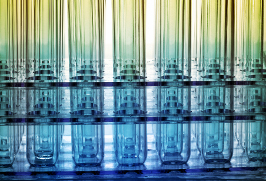Endotoxin Detection

Since the pharmaceutical industry started producing any kind of injections, pyrogen testing has become an absolute necessity. Pyrogens are substances that can cause fever, shock and, in extreme cases, even the death of an organism. Endotoxin is a pyrogen produced by gram-negative bacteria. It is found as a natural component in their outer cell membrane and released through cell lysis. Over 30 different biological activities of endotoxin are known, including macrophage activation, mitogenic activity and induction of interferon and colony-stimulating factor.
For a long time the "Rabbit Pyrogen Test" was the method of choice. The LAL test (Limulus Amebocyte Lysate) was introduced in the 1970s. LAL is derived from the blood cells, the amebocytes, of the horseshoe crab Limulus polyphemus. Frederick Bang and Jack Levin observed that these amebocytes coagulated in the presence of gram-negative bacteria. The technology for the endotoxin test was derived from this.
Selected products from our webshop:
You can find all available products in our webshop.
GEL CLOT LAL ASSAYS
The Pyrogent Gel Clot Assay is a qualitative LAL test for endotoxins from gram-negative bacteria. The assay is performed in glass tubes at 37°C. After one hour of incubation in a water bath or incubation block, the tubes are turned around 180°C. The formation of a gel-like matrix indicates the presence of endotoxin contamination.
KINETIC TURBIDIMETRIC LAL ASSAYS
Lonza offers Kinetic Turbidimetric LAL Assays for quantitative endotoxin determination. This method is carried out in a microtiter plate. A photometer measures the increase in optical density at different times at a wavelength of 340 nm at 37°C. Samples containing endotoxin show a faster increase in the OD value than non-contaminated samples. The endotoxin concentrations of samples can be determined using the standards that are carried along.
ENDPOINT CHROMOGENIC LAL ASSAYS
This method is carried out in tubes or in microtiter plates. After a certain time, the reaction mixture turns yellow and can be measured with a photometer at 405-410 nm. Positive samples result in a stronger discoloration or a higher OD value. With the help of an accompanying standard, sample values can be evaluated quantitatively.
KINETIC CHROMOGENIC LAL ASSAYS
Similar to the Endpoint Chromogenic LAL Assay, this method records an absorbance value at 405-410 nm. These tests are particularly suitable for quality control of biological products, e.g. vaccines or antibiotics. The sensitivity range is between 0.005 and 50 EU/mL.
PYROGENE ENDPOINT FLUOROGENIC LAL ASSAYS
The PyroGene Assay is a reliable alternative to conventional endotoxin tests. It is based on the activation of the recombinantly produced factor C, an endotoxin-sensitive protein, which initiates the traditional LAL cascade. The measurement is carried out with a fluorescence reader (ex: 380 nm / em: 440 nm) in a microtiter plate. Standards allow positive samples to be quantified in the range 0.01-10 EU / mL.

 Deutsch
Deutsch



